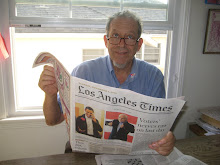Once upon a time there was an urge
to build a tower reaching to the sky.
The first one was in Babel, now a Burj
like Babel’s tower reaches in Dubai
about two thousand and six hundred feet
above the ground, a temple that was built
to hubris, an already obsolete
as boxers underneath Scotsman’s kilt.
Though built with balls, like Babel’s paradigm,
and cocky as the call of a muezzin
from a high minaret, it seems to climb
to nowhere, but it teaches us a lesson
about the way the folly of mankind
in every age attains new heights that move
its builders like the Babel men to find
new challenges to facts they must disprove.
Because I fell so sorry for the emirate,
I’ve found a way the Burj may make some money:
with hammers, Hammacher and Schlemmer it,
and sell the empty nest egg to the bunny
that we associate with Easter, when
a man who died came back to life. The Burj
may do this when investors find new men
prepared again hubristically to splurge.
In the LA Times, January 3, 2010 Christopher Hawthorne, in “A Temple to Hubris,” writes about the debut of the tallest building in the world, the Burj Dubai:
One of the odder, more complicated moments in the history of architectural symbolism will arrive Monday with the formal opening of the Burj Dubai skyscraper. At about 2,600 feet high––the official figure is still being kept secret by developer Emaar Properties––and 160 stories, the tower, set back half a mile or so from Dubai's busy Sheikh Zayed Road, will officially take its place as the tallest building in the world. Designed by Adrian Smith, a former partner in the Chicago office of Skidmore, Owings & Merrill, the Burj Dubai is an impossible-to-miss sign of the degree to which architectural ambition -- at least the kind that can be measured in feet or number of stories––has migrated in recent years from North America and Europe to Asia and the Middle East. It is roughly as tall as the World Trade Center towers piled one atop the other. Its closest competition is Toronto's CN Tower, which is not really a building at all, holding only satellites and observation decks, and is in any case nearly 900 feet shorter. Monday's ribbon-cutting, though, could hardly come at a more awkward time. Dubai, the most populous member of the United Arab Emirates, continues to deal with a massive real estate collapse that has sent shock waves through financial markets around the world and forced the ambitious city-state, in a significant blow to its pride, to seek repeated billion-dollar bailouts from neighboring Abu Dhabi. Conceived at the height of local optimism about Dubai's place in the region and the world, this seemingly endless bean-stock tower, which holds an Armani Hotel on its lower floors with apartments and offices above, has flooded Dubai with a good deal more residential and commercial space than the market can possibly bear. And so here is the Burj Dubai's real symbolic importance: It is mostly empty, and is likely to stay that way for the foreseeable future. Though most of its 900 apartments have been sold, virtually all were bought three years ago -- near the top of the market -- and primarily as investments, not as places to live. ("A lot of those purchases were speculative," Smith, in something of an understatement, told me in a phone interview.) And there's virtually no demand in Dubai at the moment for office space. The Burj Dubai has 37 floors of office space….
fall of 2008 has created an unprecedented supply of unwanted or under-occupied real estate around the world. At the same time, rising cultural worry about environmental disaster or some other end-of-days scenario has produced a recent stream of books, movies and photography imagining cities and pieces of architecture emptied of nearly all signs of human presence. And so in the same week that you could read the news that the Sahara Hotel and Casino in Las Vegas has entirely sealed off two of its three towers (and its buffet!) for the holiday season, citing slow demand, you could head to the multiplex to watch the movie version of Cormac McCarthy's novel "The Road," in which a father and son wander through a post-apocalyptic landscape where buildings for the most part have been reduced to burned-out shells.And it's not just "The Road": The Roland Emmerich destruction-fest "2012" and the upcoming Denzel Washington vehicle "The Book of Eli" are full of similar images; Jason Reitman's "Up in the Air" moves its characters through a series of downsized companies where abandoned desk chairs swim in empty space.
1/3/10
Monday, January 4, 2010
Subscribe to:
Post Comments (Atom)


No comments:
Post a Comment